
A manic thrumming and the unmistakable sound of rushing water firmly held my attention. My head snapped to port as the lee bow dug in and the stern skidded down the face of the following wave. Water sheeted up both sides of the port lee hull in a great arc. The bow began stuffing itself into the next wave, a wall of water approaching. Looking around, I saw that our wake was a great froth behind the twin hulls as the next steep wave came clipping up from behind. Clearly it was time to slow this racehorse down.
It was 2300. I’d left Boston, then arrived just a few hours ago at Gran Canaria, in the Canary Islands, where Greenboat 1, our Nautitech 542, had anchored only long enough to pick me up. The other five crewmembers had had a long trip from Brest, France, to the Canaries, and three of them were recovering from wicked coughs.
Because I was still on U.S. Eastern Standard Time and had drunk too much caffeine, I’d volunteered to take the first watch on our Atlantic crossing. While I’ve sailed monohulls all my life, a large catamaran was a new experience for me. I’d been toying with the idea of getting the crew up to put in a second reef in the giant square-headed main when a gust hit as we were surfing at 15 knots down a wave face. The autopilot wasn’t yet properly tuned for downwind sailing, and it slewed the boat to starboard. In the middle of a pitch-black night with 3,000 nautical miles still to go, I was clearly getting my baptism and first good lesson along the learning curve of becoming a multihull sailor.
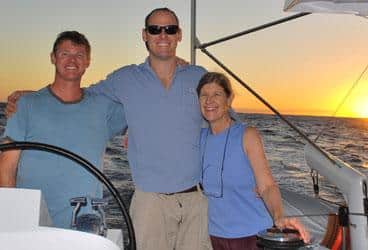
I grew up living aboard and cruising on sailboats. My wife, Jen, and I make our home aboard Lyra, our 44-foot Reliance ketch, with our two girls, ages 8 and 3. With lots of cruising and bluewater deliveries under my belt, I eagerly anticipated my first opportunity to cross the Atlantic under sail. My brother, Jesse, had overseen the assembly of this Nautitech 542 and, as captain, was now delivering it from England to the Caribbean for the winter. My mother, Troid, would be aboard, and it would fulfill her lifelong dream to cross the ocean with her family. Wisely subscribing to the rule that the mother-in-law gets what she wants, Jen agreed that I should join the crew. By getting on the boat in Gran Canaria, I’d only be away three of the six weeks required for the whole delivery. Before we knew it, it was late November, and I was on my way.
When a gray dawn arrived after that first night, it finally sunk in that I was aboard a first-class ride. The sleek Nautitech is a beautifully built vessel, designed with the plumb racing bows, low cabin house, and powerful rig of a performance cruising catamaran. With short keels on each hull and good-size rudders, the boat responds immediately to a touch of the wheel. The boat has four staterooms, each with a head and shower, crew bunks to starboard forward, a refrigerator and freezer, a 40-gallon-per-hour watermaker, and a 10-kilowatt Panda generator. Alternative power is supplied to lithium-ion batteries via six solar panels on the cabin house and a D400 wind generator. The spacious galley has a butane range top and separate oven that would turn out some of the most amazing meals I’ve eaten under way.
Our course took a gentle curve west-southwest from Gran Canaria for a few days, then hovered around due west for the remainder of the crossing. The days merged into one another, broken only by changes in our easy watch schedule and one night when we transited a low-pressure system. As daylight drew across the sky behind us, we’d often put up the gennaker, which would kick up our average speed by a couple of knots. Troid would make pancakes or eggs and bacon for those who wanted breakfast. The three fishing lines would be streamed and the genset run for an hour, along with the watermaker.
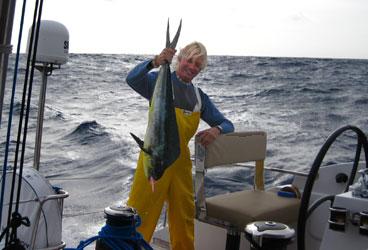
Our crewmates were entertaining: Fritz regaled us with tales of how he joined the Army at the age of 30 (when he was married with kids) to become a competition sharpshooter; Amanda practiced her classical music on the mandolin in the saloon; if we caught a mahimahi, Ken made us sushi or a curry for lunch. Often we’d read on the trampolines, deck seats, or in our bunks. A board game might be going in the saloon. About an hour before sunset, we’d gather for one of Ken’s fabulous dinners and rehash the day or discuss our progress to date. We had access to GRIB files via the satellite phone, and Jesse would update us on expected conditions and what to do if anything came up.
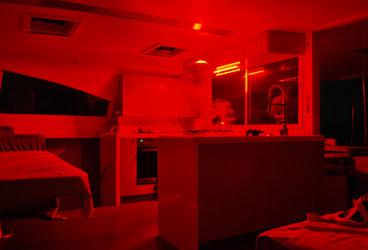
As night fell, we’d go to red lights only to preserve our night vision. We’d usually slow the boat down by reefing or dropping the gennaker by 2200 so that the off-watch crew could sleep and we’d have more margin for error if conditions changed quickly. If any rain squalls were in the vicinity, we’d use the radar to dodge them whenever possible.
As a professional sailor on an unfamiliar boat, I was up and down with every changing condition and sail change. I soon learned that if the sound of the bow wave reached my level on the top crew bunk, the boat was pushing hard. Jesse is a conservative captain, and I was aboard as an experienced hand, so I’d often pop up to see if any sail changes were required. As often as not, the crew on watch would roll their eyes and send me back to my bunk. If the main needed to be reefed or the gennaker deployed or taken in, we’d don our harnesses and take care of it.
Crossing an ocean on the trade-wind routes has always intrigued me. Too often, Jen and I have found ourselves beating to windward or in a vicious current-driven chop. Would the trades prove to be as idyllic as our cruising friends insist? Almost. This was the Atlantic Ocean, after all. We left Gran Canaria with a nice, 25- to 30-knot tailwind to push us south, so the timing seemed right.
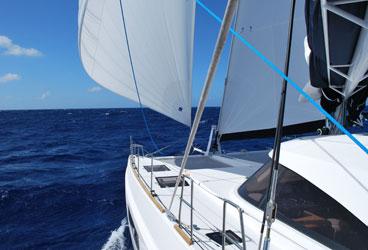
Once we left that weather system and truly hooked into the trade winds, the wave period comfortably lengthened, and the breeze moved directly aft. It might vary a few degrees or knots from sunrise to sunrise, but it was remarkably constant. We had time to get used to the motion and sounds of the boat and to establish a rhythm to moving around. Every day or two, we’d pull the weather GRIBs and see if our course needed to be adjusted.
There’s a magic to being offshore when you’re headed toward the tropics. The days steadily grow warm, clear, and humid, but not uncomfortably so. Crisply transient white wave crests on the startlingly deep, yet ever-changing blue of the sea meld with the elemental sound of rushing water and a touch of breeze on the skin. Once, in the heat of the day and 1,200 miles from shore, we stopped for a swim. A boat length away from the catamaran, I took a breath and dove under. As I spiraled slowly to the surface with my bubbles, details of both hulls were clear in the distance: the canoe shape, the keels, each rudder. Looking down, I saw rays of sunlight narrow to infinity somewhere far below, the bottom invisible more than a mile down.
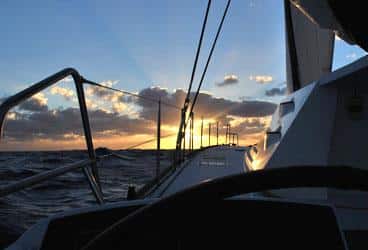
Each sunset differed from the one the evening before. There might be a blaze of orange and pinks across the sky, or it might seem that we’d skate forever over a molten ocean, leaving no trace of our passage but the ripple of wake, surrendered in moments to rollers coming from the direction of Africa. Night comes quickly in the tropics. First a few planets show; then, within a few short minutes, the hazy streak of billions of stars light the heavens. In the dark, we could often find a pinpoint of swiftly moving light—a satellite overhead. It was our only reminder of human ingenuity other than the vessel itself, faithfully carrying us to the New World. And there were meteors, sometimes dozens of falling stars over the course of a watch. Some blinked out almost immediately, while others left a trail of green or red halfway across the sky as they obliterated themselves in our atmosphere.
After the first night, we only saw the lights of one sailboat for a brief time until we were within a day of the Caribbean. Over a two-week period, we saw a total of three ships, two of which crossed our path on a tangent as we approached the islands. Even the ubiquitous blinking lights of planes were notably absent on our route.
Halfway through the passage, we encountered the top of a low-pressure system that stretched from Iceland nearly to the equator. We’d add a day to the passage if we altered course south to try to dodge it. We’d also encounter three days of light air if we took that route, perhaps adding two more days to the passage. After some discussion, the crew agreed with Jesse that it’d be best to punch through the front along our rhumb line. It was a reasonably ugly night, with steady 35-knot winds from the southwest—forward of the beam—until we plowed into the cold front.
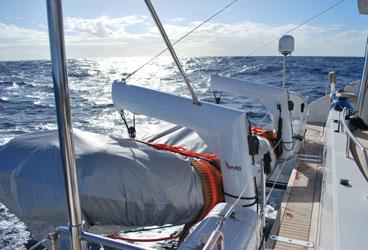
We had some noisy and sleepless hours from about sunset until my 0200 watch as conditions changed. When I came on deck, Greenboat 1‘s twin Volvos were pushing us faithfully westward at 9 knots, and the wind had mostly died as it clocked around on our bow. The Simrad broadband radar performed well, allowing us to dodge squalls as we pushed through. By the time I left the helm at dawn, the wind had shifted to the northwest, which told us that we were through the worst of it. I gained an appreciation for the warm and dry captain’s chair inside the main cabin: As rain and occasional spray coated the boat, I fiddled with the knob on the autopilot to steer around any weather cells in our path.
Two days later, we were on a glorious starboard reach and surfing along on 12- to 14-foot following seas. We hand-steered most of the day for the sheer fun of it. We sailed the boat a little bit overtrimmed at 6 or 7 knots. The helmsman watched the wave sets and the breeze to pick both a good steep wave and a well-timed puff. Once the wave was selected, a quick turn to port set us square to the wave face. If all went well, the boat began to surf, and the speed would tick up toward 12 knots. Now it was time to carve to starboard to bring the wind forward. If all continued to go well, the apparent wind would increase and the sails would suddenly be properly trimmed for our course—and away we’d go at speeds in the high teens.
Catamarans are spacious and comfortable. Unlike our boat back home, they have shallow draft, which permits gunkholing. With six of us aboard, there was space enough for each of us to find some privacy, and with a full shower in each of the four heads and a watermaker that could keep up, we were living in the lap of luxury.
Still, I found that the sailing took some getting used to. Greenboat 1 loads up so quickly with relatively small changes in conditions that in cruising mode, we intentionally didn’t sail it nearly to its potential. With its triangular rig (two shrouds and a forestay), the main can only be sheeted part way out before the giant full battens fetch up against the shrouds. Thus I had to learn to play the traveler rather than let the mainsheet run. However, Greenboat 1 always responded well to the helm, which let us bear off from the wind when required, giving us time to make adjustments. Monohull sailors may also find it difficult to adjust to the motion of the boat: It took me most of a week to be able to cross the cabin without looking like I’d just walked out of a bar.
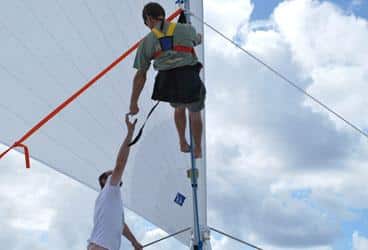
That said, the crossing was a fantastic experience, and in many ways it embodied sailing at its finest. There was time to enjoy nature, my family, and the physical act of sailing the boat. I looked forward to talking with Jen every third or fourth day for a moment on the satellite phone, and I found it rewarding to learn how to get a fix with a sextant. I found no need for all the warm clothes I packed; I could layer up just fine with a few shirts under my foulies. Without my music library on my phone, I wouldn’t have slept nearly as well in my crew-cabin bunk, with the noise of water rushing by the hulls. I brought my own comfortable harness with one stretch lanyard and one standard, and I was glad I did.
Somehow, there weren’t enough books and games aboard. Next time, I’ll bring several decks of cards and a book of game rules. Keeping up with cleaning and organization aboard was good for crew morale. We ate too much chocolate; we didn’t bring enough. After my 3,000-mile Atlantic crossing, bluewater sailing aboard our ketch with Jen and the kids seems much more attainable. I can’t wait to share a crossing and the anticipation of landfall in new places with them.
CW contributor Green Brett is a licensed captain and delivery skipper who offers his own boat for charter out of Newport, Rhode Island. This article first appeared in the June 2013 issue of Cruising World.








